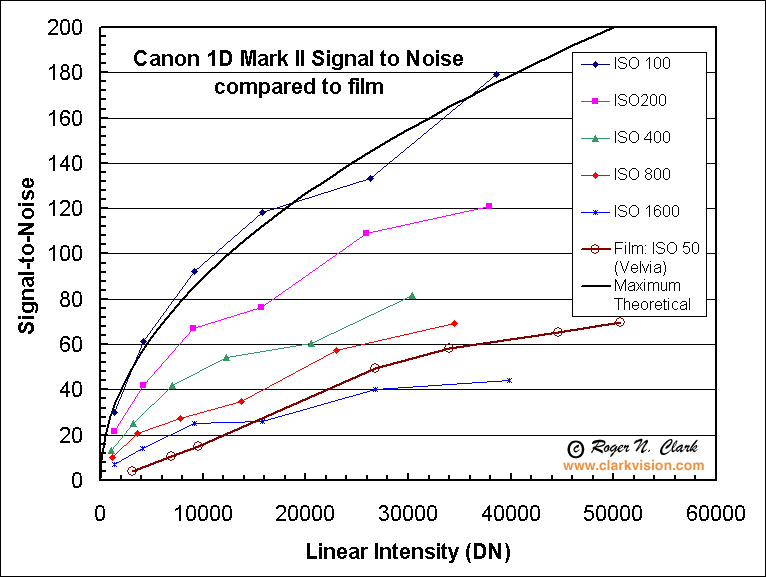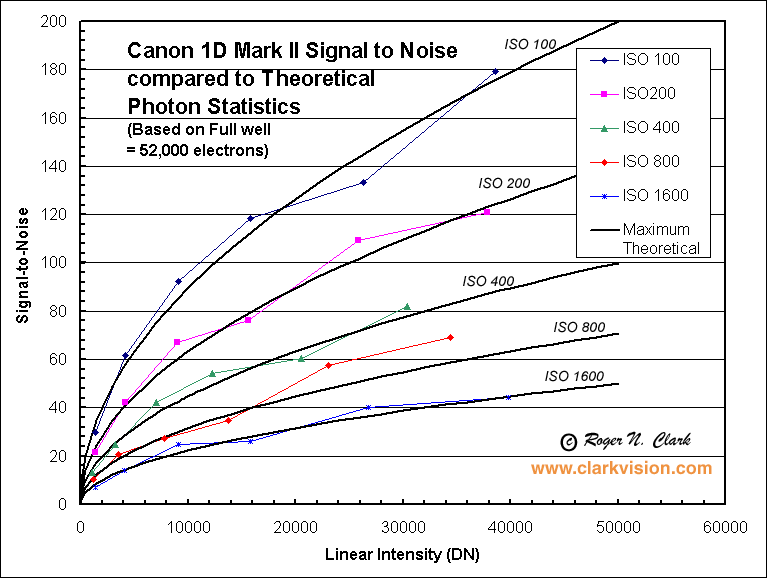ClarkVision.com
| Home | Galleries | Articles | Reviews | Best Gear | Science | New | About | Contact |
The Signal-to-Noise of Digital Camera images
and Comparison to Film
by Roger N. Clark
| Home | Galleries | Articles | Reviews | Best Gear | Science | New | About | Contact |
by Roger N. Clark
People often say that digital camera images have much lower noise, and this is true. But how much better? People wait for the next generation of cameras to come out with lower noise, but are we reaching possible limits? On this page I present some measurements that help quantify where the technology is now and show at least some cameras are at the limits in some respects.
Test were conducted to characterize the noise as a function of signal level for a Canon 1D Mark II digital camera. A series of different exposures, less than about 1/1,000 second, on a gray scale test target were made with the camera lens out of focus to reduce target non-uniformities. Each level was analyzed for signal and noise as a function of multiple exposures at each ISO setting, and at multiple ISO settings as a function of intensity of the scene. Image date were calibrated linearly to scene intensity for both the digital sensors and film. Similar work was done on scanned slides of Fujichrome Velvia, isO 50 film. The standard deviation at full image resolution was computed using ImagesPlus over a 29x29 pixel box. Multiple areas were checked for consistency in the derived standard deviation. The signal-to-noise ratio is the linear signal calibrated from the linear output of a digital sensor divided by the standard deviation at that intensity. The intensity levels were confirmed by meter readings. Scanner noise was checked and had a negligible effect on the results. The results are shown in Figure 1, below.

Figure 1. The signal-to-noise of the Canon 1D Mark II
camera at each of its ISO settings is compared to film and the
sensor's theoretical maximum. The
theoretical curve assumes the signal-to-noise is
limited by photon statistics and the full well capacity
of the sensor (see Table 3) and not by noise in
electronics in the camera. This theoretical maximum curve is independent
of the quantum efficiency of the sensor, and independent of the
transmission of the optics. Also compared is the signal-to-noise
derived from the fine-grained film, Fujichrome Velvia (ISO 50).
The data in these plots are 16-bit unsigned integer values, scaled
by a factor of 16 from the camera DN (see notes at the end of this page)
when the camera data were converted from the native raw format.
In Figure 1, we see the signal-to-noise of the Canon 1D Mark II at ISO 100 is compared to the sensor's theoretical maximum. This maximum curve was computed assuming all the noise is due to photon statistics and the derived full well capacity (at Camera DN 4095) from Table 3. Within the accuracy of the data, it shows that the 1D Mark II at ISO 100 is essentially photon noise limited. This is indicating that these high-end cameras are reaching the limits of what is possible from current technology.
The Canon 1D Mark II results mean that the only way to make a sensor with higher signal-to-noise using this same technology is to produce one with a greater full-well capacity and then somehow deliver more photons to the sensor. The reason for this is the theoretical maximum signal-to-noise is controlled by how many photons you count. sending more photons to the sensor (e.g. increasing the light intensity, getting a faster f/stop lens) would not improve the maximum signal-to-noise, unless those additional photons could be counted so you would need a large well to collect them.
Ways to improve upon the delivery of photons to the sensor includes the following.
A theoretically perfect sensor would have 100% quantum efficiency, and 100% transmission of the optics. It doesn't exist. But you would still need a larger well to improve the maximum possible signal-to-noise. Improving transmission and quantum efficiency would, however, mean you coudl reach the maximum signal to noise at a higher ISO. For example, doubling the quantum efficiency of the 1D Mark II sensor with no other changes would mean the sensor theoretical maximum curve in Figure 1 would occur ar ISO 200, not the current ISO 100.
The comparison in Figure 1 shows that the Canon 1D Mark II has a signal-to-noise at ISO 800 that is still better than fine grained ISO 50 film. At ISO 100, the 1D Mark II has signal-to-noise on the order of 3 to 6 times higher than Fujichrome Velvia, ISO 50 slide film. Higher speed films have greater grain and lower signal-to-noise.

Figure 2. The signal-to-noise of the Canon 1D Mark II camera at each
of its ISO settings (points and lines in color) is compared to the maximum
theoretically possible from photon (Poisson) statistics (black lines).
The measured values (points and lines in color) show that within
measurement error, the 1D Mark II is performing at the theoretical
maximum.
The theoretical curves in Figure 2 use the measured full well capacity at ISO 100 of 52,000 electrons. The maximum signal-to-noise is then (52000/(square root 52000) = 228. At higher ISO values, no additional photons are collected, only the gain of electrons in the well to output DN is changed. So at ISO 200, the maximum signal is half of 52,000 or 26,000 electrons and the maximum signal-to-noise drops to (26000/square root 26000) = 161. Each increase in ISO of a factor of 2 drops the signal-to-noise by square root 2, so at ISO 1600, maximum signal occurs at 3250 electrons and a maximum signal-to-noise of 57 is all that can be achieved.
Below are tables that give other derived parameters for the 1D Mark II camera along with data from the internet for comparison. Methods for determining gain and read noise can be found at references 1-5.
Table 1
Gain
(electrons/DN)
-----------------------------------------------------
1DMII 5D 20D 10D 350d 300D D70 S60
-----------------------------------------------------------
ISO 50 26.03 32.6 5.4
ISO 100: 13.02 16.3 12.4 11.4 10.2 11.1 2.7
ISO 200: 6.51 8.2 6.2 5.5 5.1 5.6 6.0 1.3
ISO 400: 3.25 4.08 3.1 2.7 2.56 2.78 2.98 0.7
ISO 800: 1.63 2.0 1.5 1.4 1.3 1.4 1.34
ISO1600: 0.81 1.0 0.8 0.7 0.6 0.7
ISO3200: 0.41 0.5 0.4
Table 2
Read Noise
(electrons)
----------------------------------------------------
1DMII 5D 20D 10D 350d 300D D70 S60
----------------------------------------------------------
ISO 50: 30.6 59.7 13.6
ISO 100: 16.6 30.1 25.3 15.9 21.6
ISO 200: 8.95 15.6 13.5 11.0 11.5
ISO 400: 5.56 8.4 7.5 10.6 7.2 6.3
ISO 800: 4.04 5.2 4.8 9.0 4.9 10 13
ISO1600: 3.90 3.7 3.6 9.0 3.7
ISO3200: 3.93 3.7
Full well depth (electrons for max DN at iso 100)
(maybe we should call this the "camera maximum DN well depth", because it is not
necessarily the real full well depth).
Canon 1D Mark II values from this study.
Canon 1DMII values determined Feb 12, 2006 with firmware 1.2.4.
Canon 10D values from Tam Kam-Fai posted on digital_astro@yahoogroups.com,
20D, 300D, D70 values from Terry Lovejoy
(
http://www.pbase.com/terrylovejoy/image/30685101 )
and
http://www.astrosurf.org/buil/20d/20dvs10d.htm
The Canon 5D, 350D, and 20D values computed from the gains
above and read nouse in DNs from Table 3 of Reference 13.
Table 3
Sensor
full Read Sensor Dynamic range Pixel
Camera well Noise (full well/read noise) Spacing Sensor size
(electrons) linear* stops (microns) Mpxl pixels mm
Nikon D2Hs ? 9.4 4.0 2464 x 1632 23.1 x 15.1
KAF-18000CE 100,000 18 5560 12.4 9.0 18.0 4904 x 3678 46.05x 35.0
Sigma SD10 ? 9.0 3.5 2304 x 1536 20.7 x 13.8
Canon 5D ~80,000? 3.7 ~20000? ~14.3? 8.2 12.7 4368 x 2912 35.8 x 23.9
Canon 1DMII 79,900* 3.9 20500 14.3 8.2 8.2 3504 x 2336 28.7 x 19.1
Nikon D70 48,800 6.3 7740 12.9 7.9 6.0 3008 x 2000 23.7 x 15.6
Pentax *ist Ds ? 7.8 6.0 3008 x 2008 23.5 x 15.7
Canon 10D 44,200 10 4420 12.1 7.4 6.3 3072 x 2048 22.7 x 15.1
Canon 300D 45,500 10 4550 12.1 7.4 6.3 3072 x 2048 22.7 x 15.1
Canon 1DsMII ? 7.2 16.6 4992 x 3328 36 x 24
Canon 20D 51,400 7.5 6850 12.7 6.4 8.2 3504 x 2336 22.5 x 15.0
Canon 20Da 51,400 3 17130 14.1 6.4 8.2 3504 x 2336 22.5 x 15.0
Canon 350D ? 6.4 8.0 3456 x 2304 22.2 x 14.8
Nikon D200 32,680 7.4 4416 12.1 6.1 10.0 3872 x 2592 23.6 x 15.8
Nikon D2X ? 5.5 12.2 4288 x 2848 23.7 x 15.7
Olympus E300 ? 5.3 8.0 3264 x 2448 17.3 x 13.0
Canon S60 22,000 13.6 1616 10.7 2.8 5.0 2592 x 1944 7.18 x 5.32
Nikon 8800 2.7 8.0 3264 x 2448 8.80 x 6.60
Canon S70 8,200 3.2 2562 11.3 2.3 7.1 3072 x 2304 7.18 x 5.32
Notes:Full Well Capacities of some digital cameras/sensors:
Table 4
camera or Ref mega full read sensor # pixels well noise comments KAI-11000CM 3 11 50,000 34 YM-3170A 4 3.17 35,000 20 Nikon DXM1200F 6 1.5 18,000 6.45 micron pixels KAF-0402ME 10 21 gain = 1.97 e/DN, Audine camera
Table 5
ISO 100
Maximum Possible Signal-to-noise Pixel
Camera Signal Maximum 18% Gray Spacing Sensor size
(electrons) card (microns) pixels mm
---DSLRs ---
Canon 1DMII 52,300 229 97 8.2 3504 x 2336 28.7 x 19.1
Canon 10D 44,200 210 89 7.4 3072 x 2048 22.7 x 15.1
Canon 300D 45,500 213 90 7.4 3072 x 2048 22.7 x 15.1
Nikon D70 48,800 221 94 7.9 3008 x 2000 23.7 x 15.6
Canon 20D 51,400 227 96 6.4 3504 x 2336 22.5 x 15.0
---P&S ----
Canon S60* 22,000 105 44 2.8 2592 x 1944 7.18 x 5.32
Nikon 8800 2.7 3264 x 2448 8.80 x 6.60
Canon S70 2.3 3072 x 2304 7.18 x 5.32
Panasonic
Lumix FZ20 2.2 2560 x 1920 5.76 x 4.29
Signal-to-noise assumes photon noise limited. Read noise, and other factors can only
degrade this number (read noise is insignificant for the maximum possible and 18%
gray card signal-to-noise ratios for the cases shown here).
* The Canon S60 full well is for ISO 50. P&S means point and shoot.
The Canon 20D full well and signal-to-noise is conditional on an initial
number that may have a large error bar.
References
1) http://www.pbase.com/terrylovejoy/image/30685101
2)
http://www.axres.com/technote1.html.
3)
Photography with an 11-megapixel, 35-mm format CCD, Kodak, 2003.
4)
http://www.dpreview.com/news/0009/00090603ymedia3mpcmos.asp
6)
http://www.microscopedealer.com/products/photosystems/nikon_dxm1200f.htm
8)
CCD Gain. http://spiff.rit.edu/classes/phys559/lectures/gain/gain.html
11)
http://www.photomet.com/library_enc_fwcapacity.shtml
Notes:
DN is "Data Number." That is the number in the file for each
pixel. I'm quoting the luminance level.
16-bit signed integer: -32768 to +32767
16-bit unsigned integer: 0 to 65535
Photoshop uses signed integers, but the 16-bit tiff is
unsigned integer (correctly read by ImagesPlus).
| Home | Galleries | Articles | Reviews | Best Gear | Science | New | About | Contact |
http://clarkvision.com/articles/digital.signal.to.noise
First published October, 2004.
Last updated September 16, 2006